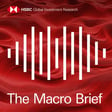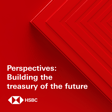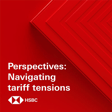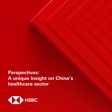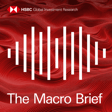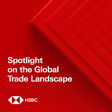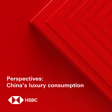Become a Creator today!Start creating today - Share your story with the world!
Start for free
00:00:00
00:00:01

The industrial boom, why silver’s in demand, and a European COVID-19 update - HSBC Global Research
Janet Henry assesses the outlook for the global industrial cycle, James Steel outlines why we are bullish on the prospects for silver and Liz Martins explains why rising COVID-19 case numbers in the UK are creating difficulties across Europe. Disclaimer
To stay connected and to access free to view reports and videos from HSBC Global Research click here
Hosted on Acast. See acast.com/privacy for more information.
Transcript
Introduction to HSBC Global Viewpoint
00:00:00
Speaker
This is HSBC Global Viewpoint, your window into the thinking, trends and issues shaping global banking and markets.
00:00:09
Speaker
Join us as we hear from industry leaders and HSBC experts on the latest insights and opportunities for your business.
00:00:17
Speaker
Thank you for listening.
00:00:28
Speaker
Hello and welcome to the macro viewpoint from HSBC Global Research, our weekly podcast featuring the views of leading HSBC analysts on the outlook for the global economy and markets.
00:00:39
Speaker
I'm Piers Butler and I'm joined by our senior UK economist, Liz Martins.
00:00:43
Speaker
Hi
Global Manufacturing and Industrial Cycle with Janet Henry
00:00:44
Speaker
Piers.
00:00:44
Speaker
Coming up this week with global manufacturing booming and supply bottleneck building,
00:00:49
Speaker
We look at the prospects for the industrial cycle with Janet Henry, our chief global economist.
00:00:54
Speaker
Silver prices have been volatile so far this year.
00:00:56
Speaker
We assess the outlook for the metal with Jim Steele, chief precious metals analyst.
00:01:01
Speaker
And governments in Europe are facing difficult decisions as we approach this summer.
00:01:05
Speaker
I'll talk through the latest COVID-19 picture.
00:01:08
Speaker
This podcast was recorded on Thursday, the 3rd of June, 2021.
00:01:12
Speaker
Our full disclosures and disclaimers can be found in the link attached to this podcast.
00:01:21
Speaker
We start with a look at the world economy, where this week Janet Henry, Global Chief Economist, has put out a major report assessing the outlook for the industrial cycle.
00:01:29
Speaker
Janet joins us now.
00:01:31
Speaker
Janet, welcome to the podcast.
00:01:32
Speaker
Hello, Piers.
00:01:33
Speaker
So, Janet, the Global Purchasing Managers Index has recorded a decade high in May.
00:01:37
Speaker
Commodity prices are soaring.
00:01:39
Speaker
And goods export volumes are rising sharply.
00:01:42
Speaker
We're seeing bottlenecks all over the place.
00:01:44
Speaker
So it really does look like a booming environment.
00:01:48
Speaker
Your point in the report that you just published is that we should really be looking a little bit more behind the headlines.
00:01:54
Speaker
Yes, when you look at the global aggregates, it all looks very good.
00:01:57
Speaker
It does look like a manufacturing boom.
00:02:01
Speaker
In fact, global industrial production is not just above pre-pandemic levels.
00:02:06
Speaker
It's actually back already on its pre-pandemic trajectory.
00:02:11
Speaker
So what I'm highlighting in the report is just that, one, there is a lot of country variations within that.
00:02:17
Speaker
Most of the, well, I suppose the most impressive aggregates
00:02:20
Speaker
reacceleration that's come through has been in China and elsewhere in Asia.
00:02:25
Speaker
We've also seen some pretty strong bounce back in some other emerging economies over the last year, and for instance, Poland and Turkey.
00:02:33
Speaker
But actually, what we sometimes forget is that some of the advanced economies, in particular Japan and Europe,
00:02:39
Speaker
entered the pandemic when they were already in industrial recession.
00:02:45
Speaker
So yes, while they are pretty much back at pre-pandemic levels, they're certainly not back at the peak of say early 2019.
00:02:53
Speaker
And in the coming year, as Europe reopens, we may actually see parts of Asia starting to slow down in terms of production from this very strong momentum.
00:03:03
Speaker
And for at least the next few months, based on that really strong survey evidence that you pointed to,
00:03:08
Speaker
we should actually see a bit more momentum being maintained in Europe.
Supply Bottlenecks and Sector Impacts
00:03:11
Speaker
So can we drill down on this whole area of supply bottlenecks and how they're likely to ease?
00:03:18
Speaker
Again, in your report, you talk about the different pace of easing of bottlenecks and what impact that's likely to have.
00:03:24
Speaker
Yes, we've seen over the last year, a very strong revival in consumer spending globally, particularly in the advanced economies where incomes were supported.
00:03:34
Speaker
And it's been a very goods intensive one.
00:03:37
Speaker
And then we go back to the start of the pandemic, our production in a lot of sectors just shut down and orders were cancelled.
00:03:44
Speaker
And so it's perhaps unsurprising given that massive rebound in demand for goods,
00:03:49
Speaker
that supply has been unable to keep pace.
00:03:52
Speaker
And in the piece, we look at a number of different sectors, but in particular what's happened to semiconductors and to timber.
00:03:59
Speaker
So consumer electronics and cars being the other big sector that obviously uses a lot of semiconductors.
00:04:04
Speaker
Timber has been a function of the revival in demand for housing markets.
00:04:10
Speaker
new house building and of course furniture that tends to go with that.
00:04:15
Speaker
But these are going to be easing at different paces.
00:04:19
Speaker
Already the indication is that a lot more investments going into the likes of semiconductors.
00:04:23
Speaker
That will take a while to come on stream, but the suggestion is we should see some easing for the auto sector chips in the third quarter, even if some shortages brought more broadly in semiconductors
00:04:35
Speaker
lasts until early 2022.
00:04:38
Speaker
And this will all impact on industrial production.
00:04:41
Speaker
We think we've seen the best of the global industrial upswing, but we're not looking for a rapid synchronized downswing.
00:04:48
Speaker
In fact, some of these sectors like cars where production's fallen over the course of the last few months in a lot of the major producers, we should see at least a mild reacceleration and perhaps in some other sectors as well, because we need to remember inventories in many sectors are at rock bottom levels.
00:05:04
Speaker
So even if underlying demand is slowing, a lot of retailers and manufacturers will want to get back to a more normal level of inventories coming through.
Inflation and Central Bank Policies
00:05:14
Speaker
So in terms of pricing and inflation, what's the outlook there?
00:05:17
Speaker
And what about central bank policy, which has been very accommodative?
00:05:20
Speaker
Well, on the pricing side, we've already seen a sharp acceleration in consumer goods prices over the course of the last year.
00:05:28
Speaker
And in particular, that was the main reason why
00:05:30
Speaker
for the sharp spike in US inflation that we saw coming through in April.
00:05:35
Speaker
But of course, what we're also starting to see is the beginning of a rotation of spending towards greater services.
00:05:43
Speaker
So these bottlenecks do mean that inflation, even on goods, is likely to remain quite sticky in late 2021 and even into 2022.
00:05:51
Speaker
But as the supply bottlenecks ease and the spending shifts towards service sector spending,
00:05:59
Speaker
we would expect inflation to be moving back down during the course of 2022.
00:06:04
Speaker
And for central banks, I think their message has been quite clear.
00:06:08
Speaker
That's basically in their forecasts.
00:06:10
Speaker
They know that inflation was seeing a spike in inflation currently.
00:06:15
Speaker
But as they've been keen to point out, what happens during reopening when you get this resurgence in demand doesn't tell you very much about the medium term outlook for inflation.
00:06:25
Speaker
And we've written a lot about this as well.
00:06:27
Speaker
Ultimately, what happens to inflation will depend on what happens in labour markets.
00:06:32
Speaker
And of course, what happens to inflation expectations, which while they're off their lows, their lows were too lows.
00:06:39
Speaker
We've got to remember that the Fed in particular has been trying to shock inflation expectations at least a little bit higher.
00:06:45
Speaker
And currently, they're not really much above where they were, for instance, back in 2013, 2014.
00:06:50
Speaker
So for central banks, it's still transitory, at least for now.
00:06:55
Speaker
Janet, thank you very much.
00:06:57
Speaker
Thank you, Piers.
Silver Market Insights with Jim Steele
00:07:00
Speaker
Let's turn to the precious metals market now and the prospects for silver.
00:07:04
Speaker
And that industrial production boom that Janet talked about has important implications for the price outlook.
00:07:10
Speaker
James Steele is our Chief Precious Metals Analyst.
00:07:13
Speaker
He spoke to Aline Van Dyne in New York earlier.
00:07:16
Speaker
Jim, you have a positive outlook for silver, highlighting that it's both an industrial and a precious metal, and that it's benefiting from good demand on both fronts.
00:07:28
Speaker
Let's start with the industrial side.
00:07:30
Speaker
What is the picture there?
00:07:31
Speaker
Well, after a rather disappointing last year due to COVID-related shutdowns and reduction in industrial production globally,
00:07:40
Speaker
Silver demand is very robust now.
00:07:42
Speaker
A little more than half of all of silver offtake is generally absorbed by industry and manufacturing.
00:07:48
Speaker
And of that 50%, fully two-thirds of that is electronic and electrical, which means that silver is reliant on chips, production, semiconductors, as well as autos, where you have an increasing amount of electronics going into autos and all sorts of consumer products.
00:08:09
Speaker
items, all of which are increasing quite rapidly right now.
00:08:13
Speaker
But silver also has traditional components to it, such as soldering, heavy industry, as well as chemicals and refining.
00:08:21
Speaker
So really, it very much reflects this broad-based industrial demand globally.
00:08:27
Speaker
And I mean, more than 100 million ounces alone goes into the photovoltaic sector, which is solar power.
00:08:35
Speaker
And silver really does very closely track swings in industrial
00:08:39
Speaker
production globally, both in emerging markets and the OECD.
00:08:43
Speaker
And we can look for good demand based on that in the near to medium term.
00:08:50
Speaker
And Jim, what about investor demand more focused on the precious metal side of the equation?
00:08:58
Speaker
Well, to that degree, silver will often parry or eight gold to some degree.
00:09:05
Speaker
And silver has benefited from investment demand on a wide range of fronts, particularly the growth in exchange traded fund demand was quite notable last year.
00:09:17
Speaker
Gathering into this year, there's been a sharp recovery in coin and bar demand as well.
00:09:22
Speaker
Now, after such spectacular year of investment demand in 2020, particularly in the ETFs, we are looking for some moderation
00:09:32
Speaker
and exchange traded fund demand.
00:09:34
Speaker
But nonetheless, we're looking for it to be positive and above historical averages.
00:09:41
Speaker
Coins and bars, small bars especially, which hit the retail market, are also strong.
00:09:48
Speaker
Although India, which is often the first or second largest importer of silver, is lagging a bit in this aspect compared to China.
00:09:59
Speaker
And Jim, on the supply side, what has been the impact of the mine lockdowns we've seen in the last year?
00:10:06
Speaker
Well, we saw a significant reduction in mine production last year due to the lockdowns.
00:10:11
Speaker
It was centered mostly in Latin America, which is coincidentally where the majority of silver is being produced now.
00:10:20
Speaker
And this had a detrimental effect on supply, which helped buoy price last year.
00:10:26
Speaker
But this year and towards the end of last year,
00:10:29
Speaker
we saw a very significant recovery in production, as well as ramp-ups and expansions in other projects.
00:10:36
Speaker
So we're looking for a significant rise in output this year.
00:10:40
Speaker
Also, something that is often not realized is that over 70% of silver is produced as a byproduct of base metals and gold, and forecasts implying increased rises in gold and base metals production will also boost silver output.
00:10:58
Speaker
But we're also seeing increases from standalone silver mines.
00:11:02
Speaker
But on the supply front, it's good to point out also that we have a significant amount of above ground stocks all over the world for silver, which can be mobilized to meet significant rallies.
00:11:14
Speaker
Recycling is also going to be higher, we think, as silver is encouraged onto the market to be recycled by higher prices.
00:11:22
Speaker
Jim, thank you so much.
00:11:25
Speaker
A pleasure, and thank you to everyone.
COVID-19 Impact on Europe and Travel Decisions
00:11:29
Speaker
Let's finish this week with the latest on the COVID-19 situation in Europe.
00:11:34
Speaker
Liz, you've been looking through the latest data, and it's fair to say there's some good news in Europe on the COVID-19 front.
00:11:41
Speaker
There really is, Piers.
00:11:42
Speaker
I mean, if you look at just the big four, France, Germany, Spain and Italy, the case numbers were down 17% compared to the previous week's COVID-19 tracker, and they're now down 75% compared to the peak in January 2021.
00:11:58
Speaker
of this year.
00:11:59
Speaker
So the numbers have come right down, so have hospitalisations, intensive care admissions, deaths and of course the vaccination rate is picking up as well.
00:12:08
Speaker
So at first, you know, the UK was running ahead on the vaccination programme, but we're starting to see European countries catch up, certainly on the daily rate of vaccination and increasingly on the percentage of the population
00:12:20
Speaker
So there is plenty of good news out there.
00:12:22
Speaker
Unfortunately, this sunny outlook is clouded by data out of the UK.
00:12:26
Speaker
Yeah, so the UK is struggling with the spread of what is now being called the Delta variant, used to be called the India variant.
00:12:34
Speaker
And that means that actually UK case numbers are picking up quite sharply, up 67% since the 5th of May.
00:12:40
Speaker
Now, in absolute terms, those numbers are still low.
00:12:42
Speaker
We're talking around three, four thousand a day.
00:12:45
Speaker
You know, hospital admissions still low.
00:12:47
Speaker
And on June the 1st, the UK celebrated its first day since the start of the pandemic with zero deaths from COVID.
00:12:54
Speaker
So that's all very good news.
00:12:55
Speaker
And the other good news, of course, is that the UK has now delivered at least a first dose of the vaccine to 75% of the adult population.
00:13:04
Speaker
And if the vaccine does its job, then despite the rising case numbers, you should see far fewer hospitalizations and deaths.
00:13:11
Speaker
But it's a bit too early to say for sure that that is the case.
00:13:15
Speaker
And some scientists are starting to worry
00:13:17
Speaker
about a possible third wave.
00:13:20
Speaker
So that really presents a set of difficult decisions for the summer ahead.
00:13:25
Speaker
It does indeed.
00:13:25
Speaker
So first of all, there's a difficult decision for the UK government because they have penciled in their final stage of lifting all the restrictions on the 21st of June.
00:13:34
Speaker
So no more social distancing, no more masks, mass gatherings allowed, all of that stuff.
00:13:40
Speaker
And some scientists are saying, look, it would be nice to do that, but maybe we should just wait a little longer, given that the numbers are picking back up again.
00:13:48
Speaker
So that's the difficult decision for Boris Johnson.
00:13:51
Speaker
But I think there's some difficult decisions elsewhere in Europe as well, because, you know, there's a lot of countries which are hoping to be put on the UK's green list of tourist destinations.
00:14:02
Speaker
Spain, for example, tourism revenues are a tiny fraction of what they were pre-pandemic, and they are desperate to get people
00:14:10
Speaker
back in and enjoying themselves on holiday.
00:14:12
Speaker
But at the same time, opening back up to the UK could risk opening up to this Delta variant and another wave of COVID infections.
00:14:21
Speaker
So the French have already made their decision.
00:14:23
Speaker
They've imposed some quite hard restrictions on entries from the UK.
00:14:28
Speaker
And the big question is whether other tourist destinations, so Spain, Italy, Greece, decide to do the same.
00:14:35
Speaker
Liz, thank you very much.
00:14:36
Speaker
Thank you.
Conclusion and Contact Information
00:14:38
Speaker
So that's it for another week.
00:14:40
Speaker
Thank you to our guests, Janet Henry and Jim Steele.
00:14:43
Speaker
And Liz, thank you very much for stepping in to co-host.
00:14:46
Speaker
From Piers and me, thanks very much for listening.
00:14:49
Speaker
We'll be back again next week.
00:14:59
Speaker
Thank you for listening today.
00:15:01
Speaker
This has been HSBC Global Viewpoint, Banking and Markets.
00:15:05
Speaker
For more information about anything you heard in this podcast or to learn about HSBC's global services and offerings, please visit gbm.hsbc.com.
